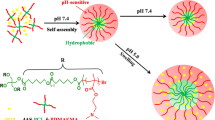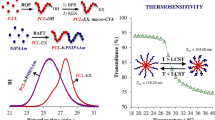Abstract
A series of novel amphiphilic block copolymers poly(propylene carbonate)-block-mono-methoxy poly(ethylene oxide) (PPC-b-MPEG) composed of hydrophobic PPC segments and various lengths of hydrophilic MPEG segments was synthesized via “Click Chemistry” between azido-terminated PPC and alkynyl-terminated MPEG. The structure of the copolymers was characterized by FTIR, 1H NMR and 13C NHR techniques. Chlorpyrifos (CHP) was encapsulated within micelles through diffusion dialysis method, leading to the formation of CHP-loaded PPC-b-MPEG micelles. The resulting micelles were characterized further by dynamic light scattering (DLS) and scanning electron microscope. The results indicated that PPC-b-MPEG could self-assemble into nanosized micelles with PPC cores and PEG shells in aqueous solution. And the size, zeta potential, morphology, critical micelle concentration of PPC-b-MPEG micelles can be altered by changing the lengths of the PEG segments. CHP was encapsulated into PPC-b-MPEG2k micelles with loading capacity of 9.02% and entrapment efficiency of 77.28%. These results suggested that PPC-b-MPEG micelles would be a potential carrier for controlled release.











Similar content being viewed by others
References
Darensbourg DJ (2007) Making plastics from carbon dioxide: salen metal complexes as catalysts for the production of polycarbonates from epoxides and CO2. Chem Rev 107:2388–2410
Inoue S, Koinuma H, Tsuruta T (1969) Copolymerization of carbon dioxide and epoxide. J Polym Sci B 7:287–292
Yang JL, Wu HL, Li Y, Zhang XH, Darensbourg DJ (2017) Perfectly alternating and regioselective copolymerization of carbonyl sulfide and epoxides via metal-free lewis pairs. Angew Chem Int Ed 56:5774–5779
Hiroshi S, Inoue S (2004) Copolymerization of carbon dioxide and epoxide. J Polym Sci A 42:5561–5573
Luinstra GA (2008) Poly(propylene carbonate), old copolymers of propylene oxide and carbon dioxide with new interests: catalysis and material properties. Polym Rev 48:192–219
Iwao O (2006) Aspects of carbon dioxide utilization. Catal Today 115:33–52
Darensbourg DJ, Ulusoy M, Karroonnirun O, Poland RR, Reibenspies JH, Cetinkaya B (2009) Highly selective and reactive (salan) CrCl catalyst for the copolymerization and block copolymerization of epoxides with carbon dioxide. Macromolecules 42:6992–6998
Luinstra GA, Molnar F (2007) Poly(propylene carbonate), old CO2 copolymer with new attractiveness. Macromol Symp 259:203–209
Shi XD, Gan ZH (2007) Preparation and characterization of poly(propylene carbonate)/montmorillonite nanocomposites by solution intercalation. Eur Polym J 43:4852–4858
Tao J, Song C, Cao M, Hu D, Liu L, Liu N, Wang S (2009) Thermal properties and degradability of poly(propylenecarbonate)/poly(b-hydroxybutyrate-co-b-hydroxyvalerate) (PPC/PHBV) blends. Polym Degrad Stab 94:575–583
Shaarani FW, Bou JJ (2017) Synthesis of vegetable-oil based polymer by terpolymerization of epoxidized soybean oil, propylene oxide and carbon dioxide. Sci Total Environ 598:931–936
Liu YL, Xiao M, Wang SJ, Xia L, Hang DM, Cui GF, Meng YZ (2014) Mechanism studies of terpolymerization of phthalic anhydride, propylene epoxide, and carbon dioxide catalyzed by ZnGA. RSC Adv 4:9503–9508
Jeon JY, Eo SC, Varghese JK, Lee BY (2014) Copolymerization and terpolymerization of carbon dioxide/propylene oxide/phthalic anhydride using a (salen)Co(III) complex tethering four quaternary ammonium salts. Beilstein J Org Chem 10:1787–1795
Liu YL, Deng KR, Wang SJ, Xiao M, Han DM, Meng YZ (2015) A novel biodegradable polymeric surfactant synthesized from carbon dioxide, maleic anhydride and propylene epoxide. Polym Chem 6:2076–2083
Wu GP, Xu PX, Zu YP, Ren WM, Lu XB (2013) Cobalt(III)-complex-mediated terpolymerization of CO2, styrene oxide, and epoxides with an electron-donating group. J Polym Sci Polym Chem 51:874–879
Hwang Y, Ree M, Kim H (2006) Enzymatic degradation of poly(propylene carbonate) and poly(propylene carbonate-co-ε-caprolactone) synthesized via CO2 fixation. Catal Today 115:288–294
Hwang Y, Jung J (2003) M, Ree, H, Kim, Terpolymerization of CO2 with propylene oxide and ε-caprolactone using zinc glutarate catalyst. Macromolecules 36:8210–8212
Tang L, Luo WH, Xiao M, Wang SJ, Meng YZ (2015) One-pot synthesis of terpolymers with long L-lactide rich sequence derived from propylene oxide, CO2, and L-lactide catalyzed by zinc adipate. J Polym Sci Polym Chem 53:1734–1741
Darensbourg DJ, Wu GP (2013) A one-pot synthesis of a triblock copolymer from propylene oxide/carbon dioxide and lactide: intermediacy of polyol initiators. Angew Chem Int Edit 52:10602–10606
Wang YY, Fan JW, Darensbourg DJ (2015) Construction of versatile and functional nanostructures derived from CO2-based polycarbonates. Angew Chem 127:10344–10348
Gungor FS, Kiskan B (2014) One-pot synthesis of poly(triazole-graft-caprolactone) via ring-opening polymerization combined with click chemistry as a novel strategy for graft copolymers. React Funct Polym 75:51–55
Liang L, Astruc D (2011) The copper(I)-catalyzed alkyne-azide cycloaddition (CuAAC) ‘‘click’’ reaction and its applications. Coord Chem Rev 255:2933–2945
Wolinsky JB, Yohe ST, Colson YL, Grinstaff MW (2012) Functionalized hydrophobic poly(glycerolco-ε-caprolactone) depots for controlled drug release. Biomacromol 13:406–411
Luo ZL, Jiang JW (2012) pH-sensitive drug loading/releasing in amphiphilic copolymer PAE–PEG: integrating molecular dynamics and dissipative particle dynamics simulations. J Control Release 162:185–193
Khorshid NK, Zhu KZ, Knudsen KD, Bekhradnia S, Sande SA, Nyström B (2016) Novel structural changes during temperature-induced self-assembling and gelation of PLGA-PEG-PLGA triblock copolymer in aqueous solutions. Macromol Biosci 16:1838–1852
Nielsen JE, Zhu K, Sande SA, Kováčik L, Cmarko D, Knudsen KD, Nyström B (2017) Structural and rheological properties of temperature-responsive amphiphilic triblock copolymers in aqueous media. J Phys Chem B 121:4885–4899
Stu B (2017) Click chemistry reaches a new dimension. Chem Eng News 95:10
Mecking S (2004) Nature or petrochemistry? Biologically degradable materials. Angew Chem Int Ed 43:1078–1085
Albertsson AC, Varma IK (2003) Recent developments in ring opening polymerization of lactones for biomedical applications. Biomacromol 4:1466–1486
John EM, Shaike JM (2015) Chlorpyrifos pollution and remediation. Environ Chem Lett 13:269–291
Jabeen H, Iqbal S, Ahmad F, Afzal M, Firdous S (2015) Enhanced remediation of chlorpyrifos by ryegrass (Lolium multiform) and a chlorpyrifos degrading bacterial endophyte Mezorhizobium sp.NH3. J Phytoremed 18:126–133
Niu YS, Li HC (2013) Alternating copolymerization of carbon dioxide and cyclohexene oxide catalyzed by salen CoIII(acetate) complexes. Colloid Polym Sci 291:2181–2189
Kiskan B, Demiray G, Yagci Y (2008) Thermally curable polyvinylchloride via click chemistry. J Polym Sci Polym Chem 46:3512–3518
Behl G, Sikka M, Chhikara A, Chopra M (2014) PEG-coumarin based biocompatible self-assembled fluorescent nanoaggregates synthesized via click reaction and study of their aggregation behavior. J Colloid Interface Sci 416:151–160
Qiu L, Hong CY, Pan CY (2015) Doxorubicin-loaded aromatic imine-contained amphiphilic branched star polymer micelles: synthesis, self-assembly, and drug delivery. Int J Nanomed 10:3623–3640
Chu YF, Yu H, Zhang YT, Zhang GY, Ma YY, Zhuo RX, Jiang XL (2015) Synthesis and characterization of biodegradable amphiphilic ABC Y-shaped miktoarm terpolymer by click chemistry for drug delivery. J Polym Sci Polym Chem 52:3346–3355
Katalin DP, Kozak CM (2017) Mechanistic studies of DMAP-initiated cyclohexene oxide/CO2 copolymerization by a chromium(III) pyridylaminebis(phenolate) complex. Chemsuschem 10:1266–1273
Li F, Xie C, Cheng Z, Xia H (2016) Ultrasound responsive block copolymer micelle of poly(ethylene glycol)–poly(propylene glycol) obtained through click reaction. Ultrason Sonochem 30:9–17
Zhang W, Fan X, Zhang H, Zhu X, Tian W (2015) Amphiphilic diblock copolymers bearing pendant aromatic acetal groups: synthesis and tunable pH-triggered assembly/disassembly transition behavior. J Polym Sci Polym Chem 54:1537–1547
Yun JM, Park SY, Lee ES, Youn YS, Park GY, Lim C, Lee BJ, Song HT, Oh YT, Oh KT (2012) Physicochemical characterizations of amphiphilic block copolymers with different MWs and micelles for development of anticancer drug nanocarriers. Macromol Res 20:944–953
Zhang LF, Yu K, Eisenberg A (1996) Ion-induced morphological changes in “Crew-Cut” aggregates of amphiphilic block copolymers. Science 272:1777–1779
Muller RH, Jacobs C, Kayser O (2001) Nanosuspensions as particulate drug formulations in therapy: rationale for development and what we can expect for the future. Adv Drug Deliv Rev 47:3–19
Georgiev GA, Sarker DK, Al-Hanbali O, Georgiev GD, Lalchev Z (2007) Effects of poly(ethylene glycol) chains conformational transition on the properties of mixed DMPC/DMPE-PEG thin liquid films and monolayers. Colloid Surf B 59:184–193
Zhang L, Zhu D, Dong X, Sun H, Song C, Wang C, Kong D (2015) Folate-modified lipid-polymer hybrid nanoparticles for targeted paclitaxel delivery. Int J Nanomed 10:2101–2114
Shim WS, Kim SW, Lee DS (2006) Sulfonamide-based pH- and temperature-sensitive biodegradable block copolymer hydrogels. Biomacromol 7:1935–1941
Bao LX, Bian LC, Zhao MM, Lei JX, Wang JL (2014) Synthesis and self-assembly behavior of a biodegradable and sustainable soybean oil-based copolymer nanomicelle. Nanoscale Res Lett 9:391–396
Wilhelm M, Zhao CL, Wang Y, Xu R, Winnik MA, Mura JL, Riess G, Croucher MD (1991) Poly(styrene-ethylene oxide) block copolymer micelle formation in water: a fluorescence probe study. Macromolecules 24:1033–1040
He G, Ma LL, Pan J, Venkatraman S (2007) ABA and BAB type triblock copolymers of PEG and PLA: a comparative study of drug release properties and “stealth” particle characteristics. Int J Pharm 334:48–55
Acknowledgements
Gratitude is expressed to the National Natural Science Foundation of China (Grant Nos. 51003051 and 51303093), Shandong Provincial Natural Science Foundation, China (Grant Nos. ZR2018MEM021 and BS2013CL007), and the High-level Talent Initial Funding for Scientific Research of Qingdao Agricultural University (Grant No. 631324) for financial support.
Author information
Authors and Affiliations
Corresponding author
Rights and permissions
About this article
Cite this article
Li, H., Sui, L. & Niu, Y. Synthesis of a carbon dioxide-based amphiphilic block copolymer and its evaluation as a nanodrug carrier. J Mater Sci 53, 12718–12730 (2018). https://doi.org/10.1007/s10853-018-2594-8
Received:
Accepted:
Published:
Issue Date:
DOI: https://doi.org/10.1007/s10853-018-2594-8




